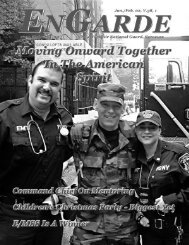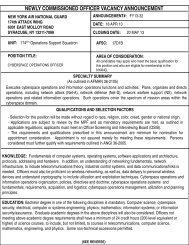1 174th Fighter Wing - Hancock Field Air National Guard Base
1 174th Fighter Wing - Hancock Field Air National Guard Base
1 174th Fighter Wing - Hancock Field Air National Guard Base
You also want an ePaper? Increase the reach of your titles
YUMPU automatically turns print PDFs into web optimized ePapers that Google loves.
MSgt. Addisson began collecting all of the necessary informationto include screen snapshots with explanations for creating thiscontinuity guide. He then forwarded the material to MSgt. Giamaswho began to lay it out in MILPDS, with the whole process onlytaking a few weeks.“Working with MSgt. Addison was a smoothcollaborative effort, he is a total professionalwho is very dedicated to his profession andthe <strong>Air</strong> <strong>National</strong> <strong>Guard</strong>”, said Giamas.Even though MSgt. Giamas was not a recruiterhe would serve as the tester for thecontinuity guide’s readability and ease inmanipulating the AFRISS program. MSgt.Addison’s desired goal was to create a continuityguide that could be used by any recruiterregardless of their familiarity with theAFRISS program. This is exactly the reasonwhy he wanted MSgt. Giamas to test the continuityguide.“If someone who was not a recruiter and had never been exposedto the AFRISS program could navigate through this system withonly the help of the continuity guide I created then I knew itwould be an effective tool”, said Addison. However, it was morethan an effective tool for using AFRISS. It changed the way potentialrecruiters were taught at the <strong>Air</strong> <strong>National</strong> <strong>Guard</strong> RecruiterCourse located at Lackland <strong>Air</strong> Force <strong>Base</strong>, San Antonio, Texas.“We built the ANG Recruiter’s course around the continuity guidemodified by MSgt. Addison, in addition to givingeach graduating recruiter a copy to takeback to their unit”, said MSgt. Mynor CastilloANG Recruiter Course Instructor. I have seenmany continuity guides that were developed toassist in using the AFRISS program, but nonewere as user-friendly and concise as MSgt. Addison’sversion, said Castillo. “For him to taketime out of his schedule and go above and beyondhis job description is a testament to hisdedication to the recruiting field and the <strong>Air</strong><strong>National</strong> <strong>Guard</strong>”, said Castillo.“When I heard about MSgt. Addison’s impacton the AFRISS system I was impressed but notsurprised. MSgt. Addison is an outstandingrecruiter; he won the 2004 ‘Flying Unit Recruiterof the Year’ award. He is a very knowledgeable professional.This attribute is visible through his demonstrated actionsand exceptional military bearing. He is the epitome of an <strong>Air</strong> Forcerecruiter”, said MSgt. Danielle Brentson 174 th Mission SupportGroup First Sergeant.I<strong>Air</strong>craft Maintenance Squadron (AMXS)By MSgt. Joe Healey, 174FW, Crew Chiefam MSgt. Joe Healey, I am a full time technician and workon the flight line as a dedicated crew chief. I am the <strong>Air</strong>craftMaintenance (AMXS) First Sergeant. My <strong>Air</strong> Force career startedin Nov. 1963. I joined the <strong>174th</strong> <strong>Fighter</strong> <strong>Wing</strong> in May of 1987.The <strong>Air</strong>craft Maintenance Squadron (AMXS) is primarilycomprised of 150 individuals spread through three differentelements (Avionics, Weapons, and Flight line). These elements’mission in life is to train our assigned personnel and generate/regenerate, employ, turn and repair our assigned aircraft. The<strong>Air</strong>craft Maintenance Flight Chief is Chief Mike Will. TheProduction Supervisor is MSgt. Jeff Drake, through our expeditor.MSgt. Ed Begel and our Element Supervisors, make all thishappen. Each element contributes in different ways along each ofthose processes. I will quickly touch on each of these elements.SMSgt. Curtis Metzger is in charge of the Avionics Element.This element is responsible to ensure the aircrafts’ communication/navigation,instrument/ flight controls, offensive and defensivesystems among others, are all serviceable and in workingorder for the pilots to use during their sorties. This element is constantlyupgrading various systems throughout the aircraft throughsoftware and hardware upgrades and the use of a good deal of testequipment. If you think it sounds like a lot, you are right. Thesepeople are the technical gurus of AMXS and deal with the mosttroubleshooting and repair of the aircraft systems and wiring.The Weapons Element is supervised andrun by SMSgt. John Fortino. To the nakedeye, these are the people who put thebombs and missiles on the aircraft so thepilots can do their job. They are responsibleto maintain the items on the aircraft(launchers & pylons) that suspend thebombs and missiles, and troubleshoot theaircraft when there are problems with the stores management system(SMS). Behind the scenes is where a good deal of this elementswork takes place. Training is really the name of the gamewhen it comes to this element. In fact, there is an entire chapter inANGI 21-101 dedicated to their responsibilities and training requirements.Last, but certainly not least are the Flightline Elements. That isplural, because we have two elements; we refer to them as "A" &"B" Flight Elements. SMSgt. Martin Brady and SMSgt. DarrylNielsen manage these. These elements contain the aircraft dedicatedcrew chiefs. Dedicated meaning that each crew chief is responsiblefor one particular aircraft. They are the people whocheck the entire aircraft over prior to, during and after every singlesortie. These people are the epitome of the "jack of all trades"phase. They are ultimately responsible for clearing that particularaircraft for flight everyday and are charged with an enormousamount of responsibility.<strong>174th</strong> <strong>Fighter</strong> <strong>Wing</strong>9
















